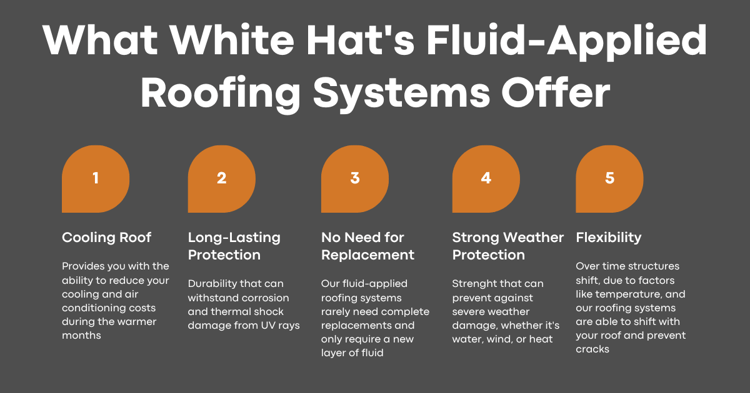Do you know the real difference between fluid-applied and traditional roofing systems?
At White Hat, our teams specialize in helping commercial facility managers, property owners, and property management groups find the best roofing solution for their building’s unique needs. With our decades of roofing experience, we’d like to provide you with the insight you need to understand the nuanced differences between fluid-applied and traditional roofing systems.
.jpg?width=750&name=TPO%20vs%20Fluid%20Applied%20-%20White%20Hat%20%20(1).jpg)
What is fluid-applied roofing?
Fluid-applied roofing systems can come in a variety of shapes and forms. However, they usually consist of a multilayered liquid solution. When applied to your roof, the liquid solution molds to its shape and creates a durable shield. Once completely sealed, this innovative solution works to repel water, severe weather, heat, and corrosion damage. Most of the time, you don’t need to replace them completely and may only need to apply a new liquid shield.
What is traditional roofing?
Traditional roofing systems can use a variety of materials, like EPDM, TPO, Mod-Bit, and Metal, and seam them together like a puzzle. When covering your entire roof in this method, it can take many pieces seamed together to protect against damages from weather, heat, and corrosion. Typically, you can expect traditional roofing systems to last between 10 and 25 years before a complete replacement is needed.
Which commercial roofing solution is better?
Whether your traditional roof is near its expiration or you’re just curious about which commercial roofing solution is better, we’d like to share our industry expertise:
Adaptability
When thinking about securing your roof, adaptability is key because structures can shift over time. These shifts might occur because of frequent changes in temperature and extremely high or low temperatures. So, it’s important to think about the type of weather your building lives in and how prominent your structure’s shifts might be.
Traditional roofing systems tend to be static and designed to stay in one place, which can lead to concerns when shifts happen. Meanwhile, fluid-applied roofing systems are designed with the flexibility to move with the structure and ensure all spaces on the roof stay protected.
Security and sustainability
Security and sustainability are cornerstones of effectively maintaining facility foundations. With traditional roofing systems, you can expect to receive temporary security that may only last a couple of decades or less, depending on external factors like weather. Comparatively, fluid-applied roofing systems offer extensive security and sustainability because they can be used on almost any roof. Additionally, this solution may never require a full replacement and is environmentally friendly with its ability to meet Environmental Protection Agency (EPA) requirements.
What can White Hat’s fluid-applied roofing systems offer you compared to traditional roofing?
At White Hat, we know that our fluid-applied roofing systems can offer you superior results when compared to traditional roofing methods. Just look at all the benefits our fluid-applied solutions can offer that traditional solutions can’t:

Secure your roof
There is no better time than today to secure your commercial roof. Our team of roofing specialists has decades of industry experience and expertise and would love to help you gain a higher return on investment when it comes to your roof.
Call us at 937.909.9030 or contact us via email to schedule your free assessment today!